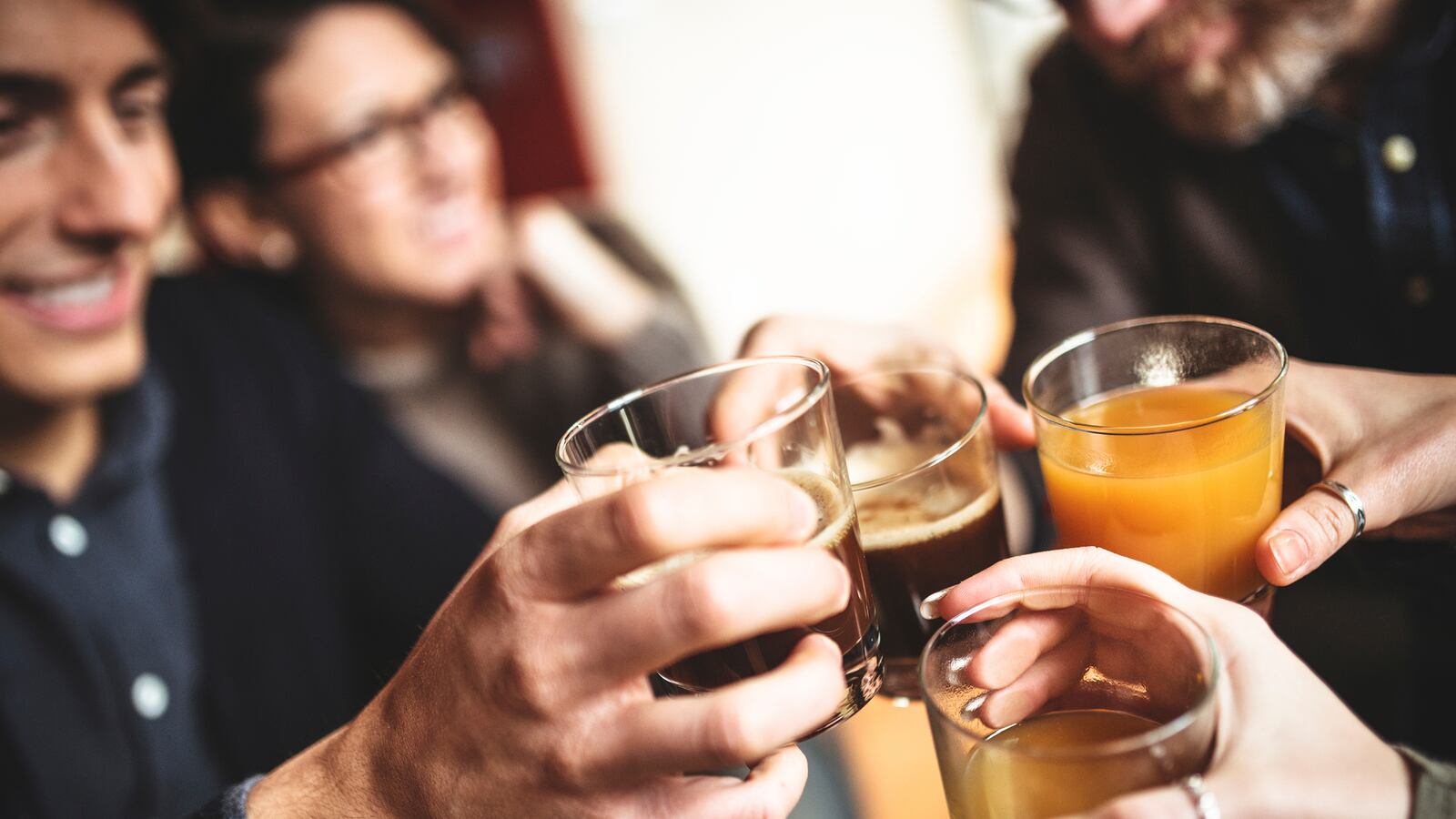It used to be I didn't need hip drinking websites or my coolest friends to tip me off to a good bar. I could identify it just by noticing a few key elements: Japanese-style mixing glasses; chilled coupes; Nick & Nora glasses (those cool ones from The Thin Man); fresh juices and house-made syrups; hand-carved ice. Perhaps even a non-dusty bottle of Chartreuse. These were usually dead giveaways a bar was legit.
But now every bar has those things…even Denny’s. That's good in theory—much better to have fresh juice that not—but it doesn't mean all these bars are good.
Brooklyn (where I live) has become masterful at throwing up bars that look good at first glance—until you enter to find an aloof bartender who hardly gives a shit as he sloppily makes you a Negroni. The drink may taste good enough and it may cost you the good bar price of $15, but you are clearly not at a good bar.
“If you’re a decent bartender, or have even a half a brain, you should be able to understand balance,” John Lermayer, of the just-opened Sweet Liberty Drinks & Supply Company in Miami, tells me. “And because of all the great cocktail books that are out there, and the PDT app (which offers an array of classic and obscure drink recipes at a single swipe), everyone can pretty much make great cocktails. It’s not a big mystery like it used to be.”
So, how does Lermayer, a nominee for American Bartender of the Year at this year’s Tales of the Cocktail Annual Spirited Awards, define a good bar in 2015?
“I compare bars to DJs,” Lermayer says. “I used to be a successful DJ, which simply meant owning a great record collection. But now that anyone with a Macbook can have a great collection, how does a DJ stand out?” he asks. “In a world where any bartender worth their weight can make a decent Boulevardier, the science is how you can make guests want to come back to your bar. I believe the only way is through hospitality and the guest experience.”
That wasn’t necessarily the case little more than a decade ago. When places like New York’s Milk & Honey, Death and Co., and even PDT opened in the early- to mid-2000s, numerous “good” cocktail bars simply didn’t exist in America. In fact, there hadn’t been an abundance of “good” bars since the Mad Men era, if not pre-Prohibition.
Thus, the most critical component of these bars was a great reverence for well-executed drinks.
But that often led to joints that weren’t exactly a barrel of laughs. Nondescript entrances with front doors nearly impossible to find was a trademark at places like the East Village's Angel's Share.
Wacky house rules included no standing in the bar and not being allowed to talk to strangers (seriously, Milk & Honey?). I even recall joints that literally didn’t play any music at all and were library-quiet.
I’ve been thinking a lot about Death and Co. of late, which was named the Best American Cocktail Bar at 2010’s Spirited Awards.
It is still highly-acclaimed in the industry, but I simply don’t have a good time going there. The last three times I’ve entered that dark, quiet bar, I’ve felt like the staff has regarded me like they’re doing me a favor by letting me spend $100 per hour to get drunk with a buddy.
Compare it to a bar just 138 feet down the block, one which also happens to be owned by Ravi DeRossi’s bar group, DeRossi Global.
Open since 2011, Amor y Amargo used to be the bar I went when there I needed to kill time for a seat to open up at the always-busy Death and Co. I eventually realized, though, Amor y Amargo is not just Death and Co.’s waiting room; it’s a vastly superior bar in this day and age.
The credit to that is mainly due to beverage director Sother Teague, one of the true gentleman of New York’s cocktail scene.
Teague is a man lavishly devoted to hospitality. He once penned a bar hospitality guide that everyone in the industry should read. A sampling: “Immediately upon entry, you will be greeted. Be that a simple nod or a bellowed ‘Hi there!’ this establishes that you’re welcome as my guest, so you no longer feel as if you’ve just wandered off the street into a stranger’s house.”
Providing not only a delicious drink but a delicious experience is exactly the theory behind Lermayer’s Sweet Liberty, which opened on Miami's South Beach.
Lermayer once called the area “the ground zero of tackiness,” more known for cheesy tourist traps, like Wet Willie’s, than high-end cocktail programs.
Still, the bar is not designed to scare the rubes away.
Yes, the front of Sweet Liberty is a 250-square foot retail store run in conjunction with the very high-end cocktail accessory manufacturer Cocktail Kingdom.
Sophisticated bar stools abound, and there may even be some fancy Japanese mixing glasses for purchase.
However, don’t let those shiny trappings fool you into thinking this bar is all surface and no substance. Sweet Liberty’s schoolhouse doors lead to an airy bar with an open kitchen and prep area, giving customers full insight into what exactly goes into his crafting cocktails.
Sweet Liberty also boasts a massive spirits collection of over 800 bottles. Lermayer offers classic drinks, of course, but he finds ways to change up the usual fare. His piña colada is made with a coconut pistachio fat wash. The house-made strawberry daiquiri combines high and low with fino sherry coming out of a blending machine.
However, Lermayer thinks the way to assure the most fun for his guests is by making his bar “bartender-driven.” That’s why Sweet Liberty’s most definitive feature is a “bartender’s table,” perhaps the industry’s first. Like a chef’s table, this six-person booth is set behind the bar and gives guests a bird’s-eye view of how drinks are made.
“It’s as interactive as we can possibly be,” Lermayer explains. “You might even have to hand us a bottle or something!”
At the same time, Lermayer’s bartenders assure each guest’s night will revolve around the kind of drink they most want to have, whether that’s an Old Fashioned, a mezcal libation, or even a vodka-based cocktail, long regarded as déclassé at snobbier bars. (Lermayer: “I’m not doing my space a service by denying people vodka.”)
Lermayer is not alone in his good time approach. The best bar owners have realized that the experience even more than the drink is what defines a good bar.
“Lots of people talk about hospitality now because they realized during the mixology craze that bartenders became like scientists or impersonal drink delivery systems. They were book nerds who could tell you what's on page 19 of The Savoy (Cocktail Book), but couldn't tell you if the Rockies won last night,” Sean Kenyon, co-owner of the Spirited Award-winning Williams & Graham in Denver, told Esquire earlier this year.
Dale Talde, the chef and restaurant co-owner behind Brooklyn favorites like Pork Slope and the eponymous Talde, agrees. “We don’t have any ‘mixologists,’” Talde tells me. “We have bartenders. They’ll talk to you if you want. Leave you alone if you want. They’ll just mainly assure you have fun.”
In New York, there are now places like Boilermaker, where a shot and a beer are actively encouraged, and the Happiest Hour, a raucous bar that offers “non-judgmental drinks”, like simple Daiquiris but also cocktails composed of house-made sodas. Sweetwater Social offers foosball but also high-end cocktails.
On the West Coast, there’s San Francisco’s Trick Dog with its delicious and silly dog-calendar themed menu. There’s a cute pooch for every month of the year paired with a stellar cocktail, while past menus have amusingly saluted take-out Chinese food and even pantone paint samples.
Nearby in Emeryville in the East Bay, Prizefighter’s entire ethos is about serving world-class drinks in a completely casual environment. In Seattle at Canon, a drink might just come served from a smoking glass skull.
These bars look and act nothing whatsoever like the “good” bar archetype that revolutionized and then defined drinking in the past decade. But they are succeeding because they’re fun, they make gorgeous cocktails you want to drink (and Instagram), and—most importantly—they have stellar employees that give you a grand experience.
“Cocktails bars used to be the only place where you could get a ‘cocktail experience,’” Lermayer says.
“Now people are ready to mix that great drinking experience with laughs, jokes, conversation, and even music. That’s what the future holds.”






